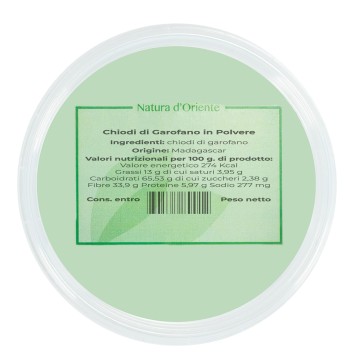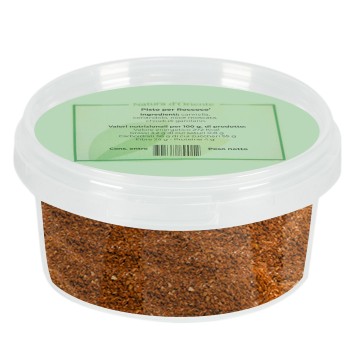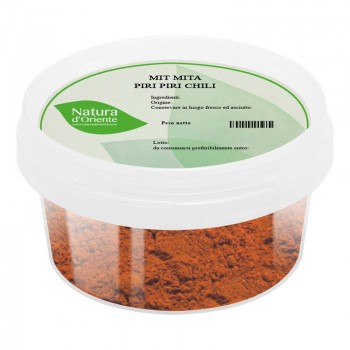An aromatic and versatile spice, made from the dried flowers of the Syzygium aromaticum tree – native to Indonesia and unrelated to the carnation. Now famous in world cuisine, cloves give a note of sweet and spicy heat to many dishes, and are also rich in antioxidants useful for our well-being. This spice is found both through dried whole buds, which turn dark brown; both in the clove powder version. The ground version allows ease of use for flavoring in the kitchen: they can be added directly to recipes without the need to grind them. With a more concentrated aromatic profile than whole nails.
Clove powder: properties and benefits
Cloves have beneficial properties known since ancient times. These are properties that make them useful for personal, home and garden care. Taken in the form of an infusion, they are considered an excellent digestive agent. They help the work of the stomach, promoting regular gastrointestinal activity; counteracting nausea and digestive difficulties. They are indicated for expelling excess intestinal gas, preventing flatulence phenomena. In terms of antioxidants, these buds are an excellent source of beta-carotene – the element that helps give cloves their deep brown color. Carotene pigments are antioxidants and provitamins - as they can convert into vitamin A, an important nutrient for our body. Cloves also help the well-being of the nose and throat with their balsamic effect; historically they were used as a natural remedy to purify and soothe irritations of the oral cavity (against bad breath, irritated gums, canker sores). As for intake, 1 gram of cloves per day could be sufficient to produce taste benefits in recipes and herbal benefits. Another property of cloves is linked to their calming properties compared to irritations. Drinking an infusion with about 3-4 flowers (equal to 1/4 of a teaspoon of ground cloves) can help relieve headaches. Cloves contain several beneficial compounds in this sense, such as eugenol, the substance responsible for the aroma, as well as minerals such as manganese and potassium. For the garden, together with garlic, cloves are a natural remedy to ward off parasites from our garden. Plus, cloves in boiling water give off a delicious fragrance, which can make your home naturally scented. For beauty, you can mix clove powder to create masks, scrubs and for hair beauty treatments. The consumption of powdered cloves must always follow moderate doses and not exceed the quantities; it is not recommended in case of ulcers for internal use or dermatitis for external use.
What uses is clove powder suitable for in the kitchen?
Powdered cloves are practical for use both with other spice blends and in recipes to add depth and flavor – to both savory and sweet dishes. They can be easily incorporated into many dishes, bringing a warm and distinctive flavour, incorporating floral and pungent notes. They are useful in many culinary applications where the texture of foods must be uniform, and they must not be removed in fillings. International cuisine: the powder of the buds is used in Indian and international cuisine for the preparation of curries, chutneys, on cured meats, in Worcestershire sauce and in English desserts, and in tea blends and is part of the 5 Chinese spices. Sweets: in our European tradition this spice is highly appreciated in baked products such as biscuits, cakes, gingerbread, desserts, creams, fruit preserves and pastry fillings. Savory recipes: Ground cloves add flavor to roasted or stewed meats, stewed and baked mains. Also used on fish and to flavor stewed or baked vegetables. They give an excellent aroma to cured meats and sausages (raw and cooked), enhancing sauces, ragù, cheeses and marinades with an intense touch. This spice is used as a condiment for first courses for an oriental touch on rice dishes, soups and legume-based dishes. Drinks: cloves are used to flavor wine (mulled wine), liqueurs and some hot drinks such as milk, tea or infusions. Blends: they can be used in the most famous ones such as garam masala and Indian curries, Lebanese baharat, ras-el-hanout, five spices and Chinese zhuatang, Berberé. Spicy tart with strawberry topping
Ingredients: 2 eggs - 1 yolk - 350 g00 Flour - 160 g of Sugar - 110 g of Cold Butter from the refrigerator - 1 pinch of Fine Salt - 25 g of Honey - 3 g of Cinnamon powder - 1 pinch of Nutmeg - 3 g of Ginger powder - 1 pinch of ground cloves - 600 g of strawberry jam - pinch of bicarbonate Preparation
Start by preparing the shortcrust pastry for the tart. Pour the flour, powdered cloves, ginger, powdered cinnamon and bicarbonate of soda into a mixer. Then add the sugar and a pinch of salt. Also grate the nutmeg into the mixer, then pour in the cold cubed butter from the fridge and the honey. At this point, turn on the mixer with the action of the blades intermittently so as not to overheat the dough too much.
Mix until you create a sandy mixture. Then turn it over onto a pastry board and form a fountain into which you will add the whole egg and the yolk, already beaten. Mix the mixture with the fork, then using your hands (quickly so as not to heat it too much). Form a loaf and cover it with transparent film. Let it rest like this in the refrigerator for at least 30 minutes. After this time, remove it from the film and roll it out with a rolling pin on a lightly floured work surface: you should obtain a thickness of about 1 centimeter.
Now take a 23 cm round perforated baking tray (or one of equal dimensions, to be buttered and flour). Using the rolling pin used to roll the pastry, lift it and spread it onto the cake tin. With your fingertips, make the pastry adhere well to the edges and with a small knife, remove the part that protrudes from the side of the mold. Recompact the excess shortcrust pastry and keep it aside. Prick the bottom of the tart with the tips of a fork and pour the strawberry jam inside. Level it using the back of a spoon and spread it over the entire surface of the mold. Roll out the leftover and compacted pastry with a rolling pin until it is about half a centimeter thick; use a pastry cutter to cut shortcrust pastry strips. Arrange the strips on top of the jam, creating a lozenge pattern. Brush the surface of the lozenges with another beaten egg. Bake in a preheated static oven at 180°C for 60 minutes (for the convection oven just cook it at 160°C for approximately 50 minutes). If it darkens too much, after about 35 minutes (25 minutes if the oven is ventilated) cover with aluminum foil. Then take the spiced tart with strawberry jam out of the oven and let it cool before turning it out of the mold, so that it becomes compact!
Origins and history of cultivation
This aromatic spice derives from the Syzygium Aromaticum plant (synonym of Eugenia Caryophyllata), native to Indonesia (Molucca Islands) - it prefers humid climate and sea air. These are the still closed buds of the plant, which once collected, after drying take on the shape of a nail and a red-brown colour. In India they were part of many spice blends, and are still used today in garam masala. In Europe and Asia these flowers spread over time, and in the Middle Ages the clove became a well-known ingredient on the table. They were called cloves, despite having nothing to do with this plant, probably because their shape took on a profile similar to the closed bud of the clove. As a valuable spice, coming from distant lands it was therefore expensive. A bunch of these little dried flowers could be worth half an ox or a ram. It was goods like this, together with cinnamon, pepper, nutmeg and others used in Renaissance courts, that made Venice's fortune in its trade with the East. The spice was also used for medicine at the time and the Arabs were the first to discover its pharmacological properties and introduce them into our territory. The Salerno School also recommended using cloves as a remedy for many ailments. While, in the 16th century, doctors prepared infusions based on milk and cloves considered powerful aphrodisiacs that "increase" the strength of Venus. The use of these flowers was even prohibited in monastic orders. They spread more widely in the eighteenth century, when explorers made this spice less rare, and cloves were increasingly used for the preservation of marinated meats, and for cooking stews and stewed meats. The clove tree is now cultivated all over the world, in the tropical belt, from the Antilles to Zanzibar up to South-East Asia, China. The world's largest producer is the island of Zanzibar in the Indian Ocean.









 No reward points for this product.
No reward points for this product.















